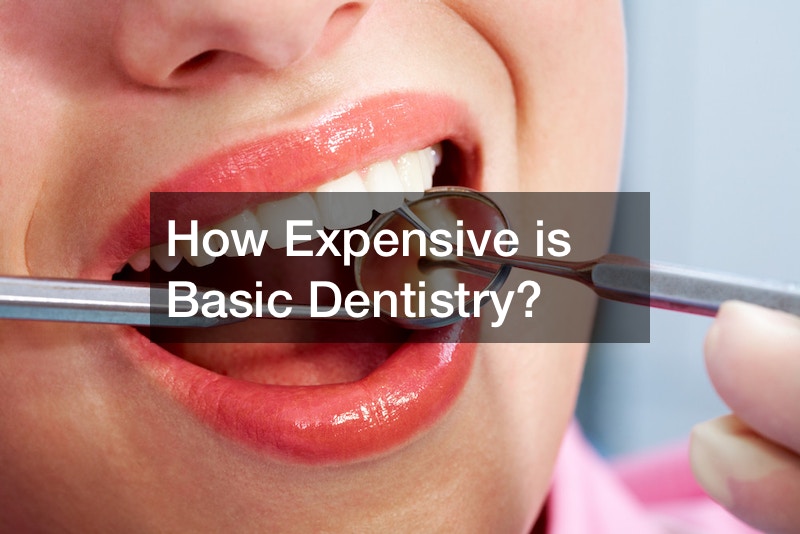
According to the Oral Health Foundation, dental services have become so expensive that some people skip dentist visits because they can’t afford them. Therefore, it’s not surprising to be worried about how much an appointment will cost you, especially if you don’t have insurance or the service you want is not covered. If you plan to visit your dentist soon, below are some of the most common basic dentistry procedures and how much you can expect to pay.
Routine Dental Appointments

A routine dental appointment, or a dental check-up, is one of the most basic dentistry services you can receive. It involves an examination of your mouth to detect any issues with your teeth, gums, and overall oral health. During the visit, your dentist can also offer additional services such as an x-ray (for a more thorough examination) and professional teeth cleaning.
The cost of a routine dentist appointment depends on the service offered and your dental insurance. According to NewMouth, a check-up can cost between $0 and $500. If you have insurance, your policy will cover all the services offered. However, if you’re paying out of pocket, you’ll be charged between $50 and $200 for a dental examination, $75 and $200 for dental cleaning, and around $200 for X-rays.
Routine dental appointments are vital as they help to keep your oral health in check and detect issues at their onset. Consequently, you can receive timely intervention, which saves you from more expensive dental treatments. Also, it can protect you from tooth loss or severe dental problems like oral cancer.
Routine dental visits are also crucial for people more prone to oral health problems. For example, people suffering from immune disorders need regular dental appointments due to the effect of their conditions on their oral health. Likewise, routine dentist visits are essential to womens health due to exceptional circumstances such as pregnancy, birth control use, puberty, and menopause that can trigger dental problems.
Dental Cleaning

Dental cleaning is another basic dentistry procedure you can expect when you visit your dentist’s office. There are two types of dental cleaning: routine cleaning offered during check-ups and deep dental cleaning (also known as scaling and root planing). During a regular cleaning, the dentist or dental hygienist uses unique teeth-cleaning tools to remove tartar and plaque buildup from your teeth’s surface and gums.
On the other hand, deep dental cleaning involves removing built-up dental plaque, tartar, and oral bacteria below the gum line. Depending on your oral health condition, the dentist might also apply an antibiotic treatment to kill bacterial infection. Lastly, they will smooth out the teeth (planing), which allows your gums to reattach themselves.
So, how much can you expect to pay for dental cleaning services? According to Authority Dental, you can expect to pay between $70 and $250 to have your teeth cleaned professionally. However, the cost might be higher if other services, such as dental examinations and X-rays, are offered. Nonetheless, teeth cleaning is usually covered by most dental insurance policies, so you might not have to pay anything.
Dental cleaning services are crucial as they remove oral bacteria buildup in your mouth. This helps to avert a range of oral health issues such as cavities, gum disease, and tooth loss. It can also prevent other health issues like heart disease and respiratory illnesses, which might require you to visit a medical doctor for extensive treatments.
Dental Braces

Dental braces treat orthodontic issues like gapped, crooked, crowded, and misaligned teeth. The braces work by applying pressure to the teeth, forcing them back to their correct position. This helps to give you nice-looking teeth that are great for your smile. On top of that, straight teeth are easier to clean; hence braces can help prevent oral health issues stemming from poor oral hygiene.
There are two main types of dental braces: fixed braces that use metal brackets and ligatures and removal braces (aligners). A good example of a removable aligner is Invisalign, which is virtually invisible, making it perfect for people who prefer less noticeable braces. Other benefits of invisible aligners include better comfort, ease of cleaning your teeth, and fewer limitations on your diet.
Dental braces might be a basic dentistry procedure, but they are also one of the most expensive ones. According to Oral B, the treatment can cost between $3,000 and $10,000, depending on your desired braces. Traditional metal braces are usually the cheapest, with special braces such as aligners and invisible ceramic braces being more expensive. Unfortunately, in most cases, you might have to pay for dental braces out of your pocket, as they are usually considered cosmetic dental procedures.
Dental Crowns
A dental crown procedure is a basic dentistry solution that is used in the restoration of damaged teeth. This can include broken, decayed, eroded, weak, crooked, permanently discolored, or sensitive teeth. The crown, which is an artificial ‘tooth cap,’ is placed over the problematic tooth, restoring its function and appearance.
A dental crown procedure is relatively simple; it starts with taking an impression of your teeth to create a crown similar to your natural teeth. Then, the damaged tooth is prepared by removing part of its enamel, providing space for the crown to be installed. Lastly, the tooth is thoroughly cleaned and treated (in case of cavities) before the crown is placed and permanently cemented.
One of the top benefits of dental crowns is that they offer a long-term tooth restoration solution. According to Healthline, the restored teeth can last around ten years (on average). During this time, you’ll take care of your crown like your natural teeth — regular brushing, flossing, dental visits, teeth cleaning, etc. And should you experience any issues, you can visit your dentist for a crown repair or replacement, thus extending their lifespan.
In terms of cost, dental crowns are a relatively expensive procedure. According to the Consumer Guide to Dentistry, you can pay between $1,000 and $3,500 per single crown placement. And unfortunately, your insurance policy may not cover the procedure unless deemed medically necessary.
Dental Bridge
A dental bridge procedure is another basic dentistry solution for teeth restoration. The bridge is an artificial tooth that replaces one or more missing teeth. Crowns or implants are then used on both ends of the bridge to fix it in the mouth permanently.
Dental bridges offer several benefits to people who have suffered tooth loss. First, replacing the missing teeth helps restore full oral functionality, especially in chewing and speaking. Secondly, the bridge prevents the shifting of the remaining teeth in the mouth, which can otherwise lead to several oral health issues. Lastly, they can help to restore your smile by fixing gaps in your mouth with beautiful, natural-looking teeth.
Like crowns, dental bridges are a long-lasting tooth restoration solution. According to Cleveland Clinic, the average lifespan of a dental bridge is seven years, but some can last up to 15 years with proper care. Therefore, you must brush frequently, floss, schedule regular dental appointments, and observe other oral hygiene practices if you want your restored teeth to last.
In terms of cost, a dental bridge can be expensive. According to Dentaly.Org, you can spend between $500 to $5,000 during the procedure. However, you could also pay more depending on the tooth’s material, the method used to fix the bridge, and the number of missing teeth. Unfortunately, most insurance plans will not cover dental bridges, while those that do will have a sum amount or percentage limit.
Dental Implant
A dental implant procedure may not be the most basic dentistry solution, but it’s vital for tooth restoration. The implant is an artificial tooth-like crown, which is permanently fixed onto the jawbone using screws in the place of the missing tooth. You can get a dental implant procedure to replace one or several missing teeth in your mouth.
Dental implants offer several benefits, starting with restoring full oral function. Also, since they are implanted directly on the jawbone, they help prevent bone loss while keeping the adjacent teeth stable. In addition, dental implants look and feel like natural teeth and thus can help to give you a fantastic smile.
The most significant benefit of dental implants is their longevity. According to Healthline, the restored teeth can last a lifetime with proper oral care. However, in some cases, the procedure can fail, in which case you can have the implants removed and replaced with a new one or another solution like a dental bridge or a denture.
Cost-wise, dental implants are one of the most expensive dental procedures, even more than crowns and bridges. According to the Dental Health Society, a single implant costs around $4,800, while a complete mouth implant costs about $75,000. And like most dental procedures with an aesthetic element, insurance policies do not usually cover the treatment. However, you can find a few good private dental insurance plans that cover a portion of the procedure’s cost, thus offering you affordable dental implanting solutions.
Cosmetic Dental Procedures

Cosmetic dental procedures are another excellent oral health solution when visiting a dentist. Unlike other dental treatments, cosmetic dentistry deals with aesthetics, with the procedures offered to give you a bright, white smile. So, if you’re not happy about the appearance of your teeth or are a bit self-conscious about your smile, these are the perfect service for you.
Cosmetic dentistry is broad, involving a wide range of dental solutions. These include basic dentistry procedures like teeth cleaning, teeth whitening, dental bonding, teeth shaping, veneers, porcelain fillings, etc. It might also involve some dental restoration procedures like braces, aligners, dental crowns, bridges, and implants, offering functional and aesthetic benefits.
Cosmetic dentists can also offer more extensive and invasive procedures to help improve your smile. Top examples include gum contouring and jawline surgery. In addition, some dental offices offer an inclusive full smile makeover procedure, where several cosmetic and restorative dental solutions are used to fix all of your teeth issues, thus giving you a perfect smile.
When it comes to cost, the amount of money you spend will vary depending on the procedure received. For example, according to Consumer Guide To Dentistry, a teeth whitening procedure will incur you between $100 and $650. On the other hand, according to RealSelf, the average cost of a smile makeover procedure is around $11,000, but it can be as high as $33,000 (or more). And unfortunately, most dental insurance plans will not cover cosmetic procedures – and those that do only offer partial coverage.
Laser Dentistry
Laser dentistry is another top dental solution in a dental office. It involves using dental lasers during various procedures as an alternative to traditional dental treatments. According to Dentalcare.com, laser dentistry has been in use since the 1990s. However, it’s only recently that the practice is becoming more popular.
In the dental world, lasers are used in various treatments, including basic dentistry procedures such as teeth whitening. They can also be used in processes like tooth decay and gum disease. On top of that, they are popularly used as cutting and tissue vaporization tools during dental surgeries.
Laser orthodontic treatments are another top example of the use of lasers. It involves using lasers during orthodontic treatments, for example, etching the enamel in preparation for dental bonding or placement of crowns and veneers. Other examples include bone remodeling, gum tissue contouring, tissue removal during braces treatments, etc.
Laser dentistry treatments can offer you many benefits over traditional procedures. First, lasers produce less pain, bleeding, and inflammation. They also have a lower risk of infection since they are sterile. Lastly, they are more precise than traditional cutting tools and promote quicker healing.
In terms of costs, laser treatments will vary depending on the procedure you’re receiving. For example, according to Healthline, a laser teeth whitening procedure will cost between $400 and $1,800. For other laser-assisted dental procedures, the cost of dental treatment might increase by a few hundred dollars due to the use of lasers. And as for the insurance, the coverage will depend on the type of procedure you’re receiving; restorative treatments will likely be covered, while cosmetic ones might not.
If you’re worried about how much your next dental visit will cost you, the above figures will put your mind at ease. They include costs for some basic dentistry procedures and the more advanced ones vital for oral health. The good news is that most of them are fully or partially covered by insurance plans, thus providing you with an excellent solution for affordable dental care.



